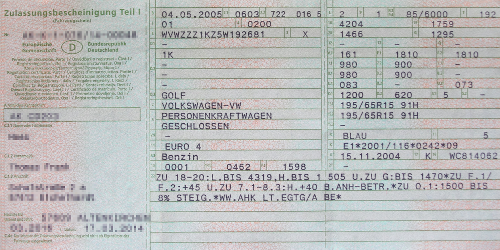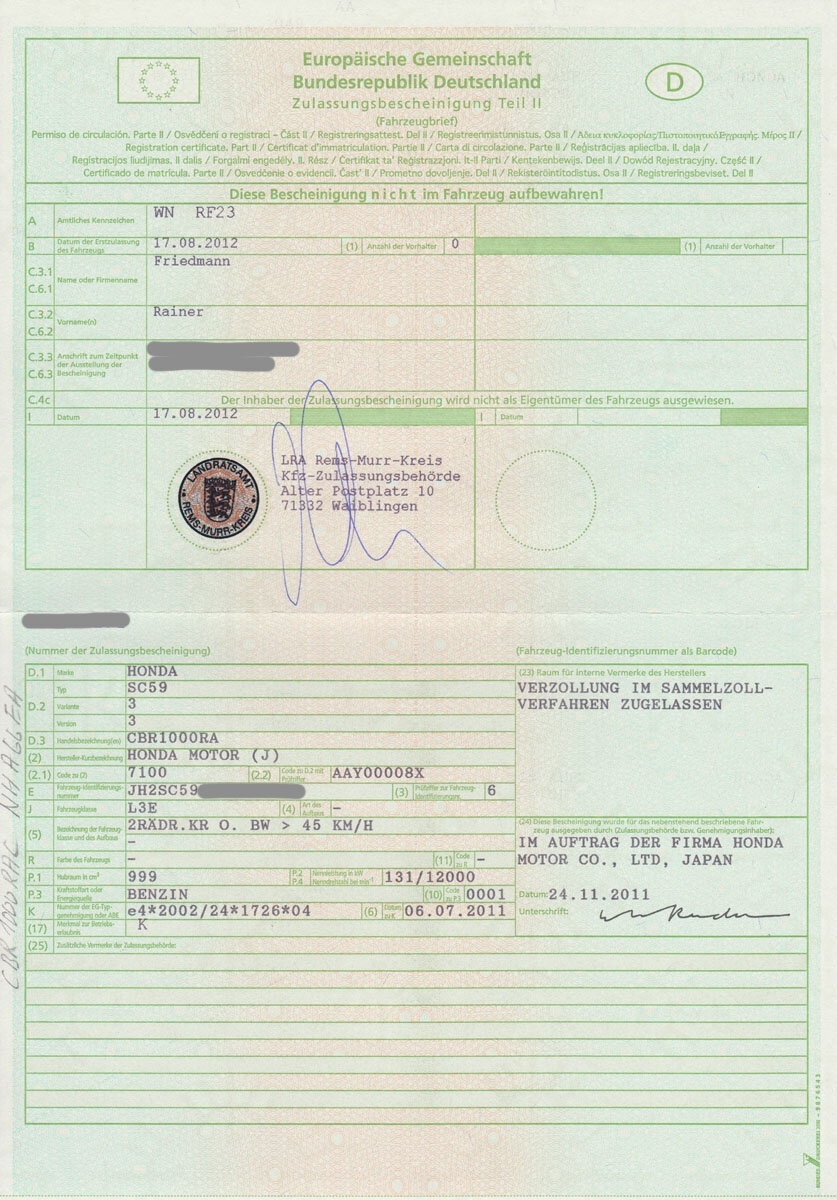

Lucas and I with our new friend, Carla, the European version of the Ford Fusion…a manual edition!
Alright, this post is for all of those who need some freedom from the very convenient public transportation or want to learn what a complex process we have to go through to legally drive in Germany. Here, there are options of public busses, subways, as well as regional, intercity, and city trains to get around the country. But it is a challenge to get off the map and do a little wandering, as well as you always have to rely on being back to a location by a certain time so you can make the next train. Arriving from a plane late at night? You can bet on the busses only coming every 30 minutes or more. And not all public transportation is available around the clock.
Lucas and I were considering buying a vehicle, as we could use it to get to adventure and hiking destinations much easier, as well as travel further into other parts of Germany without having to fly or take a 5 hour + train.
Driver’s License:
Americans are allowed to drive in Germany with their American driver’s license for about 6 months after the date of your arrival. If you are here longer than 6 months, you need to get a German driver’s license. The process for this is quite simple for half of Americans. Currently (as of January 2020), the following states have been issued exempt from taking a German road test:
-
Alabama
-
Arizona
-
Arkansas
-
Colorado
-
Delaware
-
Idaho
-
Illinois
-
Iowa
-
Kansas
-
Kentucky
-
Louisiana
-
Massachusetts
-
Maryland
-
Michigan
-
New Mexico
-
Ohio
-
Oklahoma
-
Pennsylvania
-
South Carolina
-
South Dakota
-
Texas
-
Utah
-
Virginia
-
West Virginia
-
Washington State
-
Wisconsin
-
Wyoming
-
Puerto Rico
Here is the link to check the updated list: https://de.usembassy.gov/u-s-citizen-services/local-resources-of-u-s-citizens/living-in-germany/driving-in-germany/
If you have gotten your driver’s license in one of these states, the process will be much easier for you. You have to make an appointment for Umschreibung für eine ausländische Fahrererlaubnis (transfer of a foreign driver’s license). For this, you need:
-
Your passport or personal ID,
-
A current biometric photo (you can usually get this at a little photo booth at the main train stations (Hauptbahnhöfe) or any photo studio
-
Around 35 Euros to pay the fee
Some places also require you to have proof of First-Aid training (If you do not have this, you can research places online like the Red Cross that do this as a weekend course), and the results of a recent eye examination. You do not usually need to have a translation of your driver’s license, as long as it is in English and you are from one of the above states.
If you are from one of the states that was not mentioned, you may need to take a German road test and have a translation of your license made (this you can get from your local ADAC office), along with the above-mentioned documents.
* A note to the sentimental folks out there: when you get your new driver’s license, they take your old edition and keep it. There is no way you leave the office with it, so make sure you have a copy of it or a photo of it if you value saving it for some reason.
**Another special note for those who get a motorcycle license or other special driving license after being in Germany for 6 months- the special license must be from Germany. Lucas and I tried to get motorcycle licenses in the US this summer, and they would not let us apply these to our German licenses, because we did not get them from Germany. If you would like to get any special licenses, make sure you do this before you come or get them from Germany.
I would also check into applying for an international driver’s license. This is valid in non-European countries like the US and Canada. They can usually do this in the same visit and all you need is an additional biometric photo, and some extra cash. This covers you if you need to show proof of your driver’s license in non-European countries. This typically costs around 20 Euros.
Buying a vehicle
We then decided to look for vehicles for under $3000 on ebay kleinanzeigen (ebay classifieds). Autoscout24 and mobile.de are also good sites. We found a few cars that seemed decent, and we were looking for something with around 50,000 kilometers (25,000 miles), which usually means the car has much life still left in it.
After calling and checking around for a few, some got sold quite quickly. We then found a European Ford Fusion for $3000, which was an hour and a half away. The man had just posted the ad a few days before. The vehicle was a 2003 and had 45,000 km on it. This is a really good mileage for it’s age- typically, a good car averages about 20,000 km a year (10,000) miles, when it has not been overused.
We then called the man, and wanted to go to see the vehicle. But the issue is, to take the vehicle for a test drive, you need to have temporary plates, which you must get from your local KfZ: Kraftfahrzeugzulassungsstelle (DMV). But in order to do this, you need:
-
a copy of the Zulassungsbescheinigung Teil 1 (the registration) from the owner of the vehicle (see photo below)
-
Your passport or personal identification
-
A temporary insurance (EVB) number. This is something Germany requires you to have- insurance before you even own the vehicle. Use websites like Check24 to find you the cheapest insurance for your needs. Make sure you get the insurance for the city


This is what the Zulassungsbescheinigung Teil 1 looks like.
With these items, you can then get temporary plates to test drive the vehicle. You will not be able to get plates at another KfZ in another city- for example, if you live in Berlin but find a cheap car in Munich, you will not be able to get temporary plates in Munich at the KfZ. You have to get the temporary plates from the KfZ in the city where you live. These cost usually around 35 Euros. The temporary plates are only good for 5 days. After that, you must go back to the KfZ in your city and get long-term plates (Kennzeichnen).
It did not work for us to go look at the car, and somehow we worked it out that the owner would bring the vehicle to us for us to look at. This is a rarity, because we gave him no guarantee that we would buy it. We also had to pay extra for him to get a train ticket to get back home, but it was worth it. We checked out the vehicle, and it was in really good condition. It was owned by an older man who had recently passed away. Generally, the vehicles owned by older, retired people are the best to have because they have usually been well cared for and don’t usually have high miles.
Upon purchase of a vehicle, make sure you:
-
print and sign a copy of the contract of the purchase. A copy should go to the seller and the buyer. The link below has a contract you can use. https://www.adac.de/-/media/adac/pdf/jze/kaufvertrag-privat-an-privat.pdf
-
Make sure you get proof of all previous maintenance
-
Zulassungsbescheinugung Teil 1 (Proof of registration Part 1)
-
Zulassungsbescheinigung Teil 2 (Proof of registration Part 2, see photo below
-
Valid HU or Hauptuntersuchung (certificate of mechanical soundness. These must be performed every two years).


A sample of the Zulassungsbescheinigung Teil 2. This is more like the title for the vehicle.
Without these, you will have a hard time registering your vehicle and transferring the title to your name). You also need to make sure you inspect the vehicle inside and out. We did look at the engine, tires, and inside of the vehicle, but did not go over all the small details like adjusting the mirrors and folding down the seats. If we would have, we would have found that the back seat did not fold down on one side, and the passenger mirror was not adjustable. We could have saved some cash! Make sure you look your car over, up and down, inside and out!
We then had to go to the KfZ again, to get real license plates and our official German driver’s licenses. Make sure when you go to the KfZ, that you either confirm an appointment online a few weeks ahead of time, or you go that day really early. There is usually really long lines at government buildings early in the mornings for the same day appointments. The earlier you get there, the quicker you can get an appointment and get in and out.
Long-Term License Plates
To get long-term license plates, you need the following:
-
Your passport or personal ID
-
Zulassungsbescheinigung Teil 1 (registration part 1)
-
Zulassungsbescheinigung Teil 2 (registration part 2)
-
Documentation of a valid Hauptuntersuchung or HU (this is a mandatory inspection done every two years on the vehicle to make sure everything is mechanically in order
-
Around 50 Euros to pay for the fee
At the appointment, they will take the papers and transfer them to your name. Then, they will give you papers to get license plates. You need to go to one of the shops in or around the building that sell license plates. They print them for you, and cost an additional 40 Euros.
After the plates have been printed, you need to take them back up to the person who helped you in the KfZ. They put a stamp on the license plates and make everything official.
Then you are finally done with the officials and can go home to your shiny new ride!
“KILOMETERS ARE SHORTER THAN MILES. SAVE GAS, TAKE YOUR NEXT TRIP IN KILOMETERS.” – GEORGE CARLIN